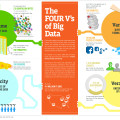Data science has become not only a trend in business analytics in recent years but an essential business tool. Massive amount of data are now within reach – and the ability to grasp every granular detail these data give brings a wealth of information and insights. There is an increased demand for data management services because of this realization.
Data science has become not only a trend in business analytics in recent years but an essential business tool. Massive amount of data are now within reach – and the ability to grasp every granular detail these data give brings a wealth of information and insights. There is an increased demand for data management services because of this realization.
This is the primary reason why business managers should get a grasp of data analytics. It is a common misconception that data analytics is a technical process that managers get too overwhelmed and intimidated to learn, when in fact, data analytics really do not focus on technical skills but thinking skills – something that managers are supposed to be experts in.
Florian Zettelmeyer, a professor of marketing and faculty director of the program on data analytics at the Kellogg School, said it best, “Managing well with analytics does not require a math genius or master of computer science; instead, it requires “a working knowledge” of data science.” This means being able to separate good data from bad, and knowing where precisely analytics can add value. This is the point where managers are exactly needed and where they need to excel in.
Here are some essential principles of data analytics that managers need to learn. You will find that these are more thinking and managerial than technical:
Start with the Problem
Managers need to start thinking that analytics is integrated with the business plan, it’s not a separate operation. Analytics all start with a problem and it is the manager’s job to choose which problems need to be solved and how the company should incorporate analytics into its operations. Executives, after all, are the ones who have to make decisions; therefore, they should play a central role in determining what to measure and what the numbers mean to the company’s overall strategy.
As managers, you steer the direction where analytics is supposed to go — from data generation, collection, evaluation, and implementation.
Understand the Data-Generation Process
For managers to be able to distinguish what is good and bad analytics, they need to have an understanding of the data-generation process. One cannot judge the quality of the analytics if you don’t have a very clear idea of where the data came from. To make informed decisions and to be able to decipher the worthiness of an evaluation, it helps to take a step back and identify how and where the data were collected.
For example, because analytics often boils down to making comparisons between groups, it is important to know how those groups are selected.
Use Domain Knowledge
What’s the manager’s domain knowledge? It’s the business itself.
In addition to making sure that data is generated with analytics in mind, managers should use their knowledge of the business to account for peculiar results. Data scientists do not have all the domain expertise managers have, and analytics is no substitute for understanding the business.
Understanding Different Types of Data and Their Implications
It is important to know about the differences between various types of data so you will be able to identify which ones are needed in different problems you want to find solutions for.
The commonly used analytics before were just purely descriptive — simple reports or dashboards with numbers about what happened in the past. Now there are predictive, prescriptive and even automated analytics.
Predictive analytics use statistical models on data about the past to predict the future. Prescriptive analytics create recommendations for how workers can make decisions in their jobs. Automated analytics that make analytical decisions are made by computers. Many common analytical decisions, such as those about issuing credit by banks or insurance policies, are made entirely automatically.
Managers need to explore which type is helpful again, to the problem they want to solve or a question they are trying to find answers for.
Have a working knowledge of data analytics so it will work better for you
Getting a grasp on these fundamentals won’t make you an analytics expert, but it will make you a more effective consumer of this essential business tool.
Managers or leaders can combine their domain knowledge and analytics into genuine insight that is valuable to the business. It can also help them make sound business decisions instead of just going by assumptions or gut feel.












Recent Comments